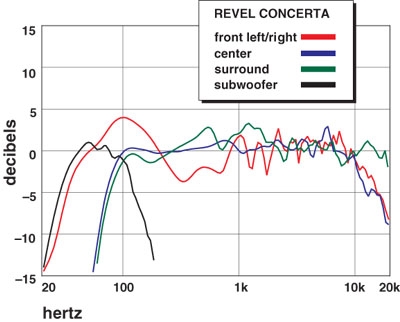Revel Concerta home theater speaker system Page 3

Test Bench: Revel Concerta Home Theater Speaker System by Tom Nousaine
Frequency response (at 2 meters) front left/right: 37 Hz to 14 kHz ±3.9 dB center: 79 Hz to 11 kHz ±3.0 dB surround: 86 Hz to 19.7 kHz ±3.1 dB subwoofer: 32 Hz to 115 Hz ±2.0 dB
Sensitivity (SPL at 1 meter with 2.8 volts of pink noise) front left/right: 91 dB center: 90 dB surround: 87 dB
Impedance (minimum/nominal) front left/right: 2.9/6 ohms center: 3.3/7 ohms surround: 2.9/8 ohms
Bass limits (lowest frequency and SPL with limit of 10% distortion at 2 meters in a large room) front left/right: 25 Hz at 77 dB center: 80 Hz at 94 dB surround (switch in bipole position): 80 Hz at 87 dB subwoofer: 20 Hz at 80 dB average SPL from 25 to 62 Hz: 100 dB maximum SPL at 62 Hz: 107 dB bandwidth uniformity: 94%
All of the curves in the frequency-response graph are weighted to reflect how sound arrives at a listener's ears with normal speaker placement. The curve for the left/right front channels reflects response of the floorstanding F12 averaged over a ±30° window, with double weight at 30° (the most typical listening angle). The center-channel curve reflects response of the C12 averaged over ±45°, with double weight directly on-axis of the primary listener. The surround-channel curve shows the response of the S12 averaged over ±60°.
The F12 had highly uniform directivity and deeper, stronger bass capability than many larger speakers, with slight peakiness above 1 kHz and a shallow trough between 200 and 700 Hz. Although the top octave had softly falling response, I also observed a tweeter resonance at 24 kHz (not shown in graph), but this won't be audible.
The C12 center speaker shared this last characteristic and also the tightly controlled directivity. That's unusual for a low-rider center speaker and is apparently due to the vertically arrayed midrange/tweeter complement, which completely frees the C12 from the off-axis lobing so common with such speakers.
The S12 surround had characteristics common to dual-face speakers. Both sensitivity and bass limits were reduced in the dipole and monopole settings. Further, there was a moderate amount of lobing when I measured the speaker from far off-axis with its bipole or dipole setting engaged. These results are typical for these types of speakers and generally not problematic for a surround. In the monopole setting, frequency response was marginally smoother but fell significantly below 400 Hz.
The B12 subwoofer's bass limits were measured with it set to maximum bandwidth and placed in the optimal corner of a 7,500-cubic-foot room. In a smaller room users can expect 2 to 3 Hz deeper extension and up to 3 dB higher sound-pressure level (SPL). The B12 had good low-end extension but moderate overall SPL capability. Although the crossover control is marked from 50 to 175 Hz, the actual acoustical turnover frequencies ranged from 52 to 115 Hz. The B12 had useful response up to 152 Hz when the crossover was bypassed.
The subwoofer provides three room-correction EQ controls for taming the most common low-frequency mode in typical listening rooms: a Center Frequency knob to select the center of the equalization band, a Bandwith dial to select the range of frequencies affected on either side of that center, and an EQ control to dial in the amount of attenuation. The Center Frequency and Bandwidth controls were reasonably accurate (within 10% of their marked settings), but the actual acoustical attenuation varied significantly from the markings of the EQ control. When the EQ knob was set to its -15-dB mark, the measured attenuation varied between -4 and -12 dB depending on how the Center Frequency and Bandwidth controls were set. Although there was only 4 dB of level/crossover interaction over the full range of the crossover control, the Bandwidth, Center Frequency, and EQ controls exhibited twice that much level interaction when adjusted to different settings.








































